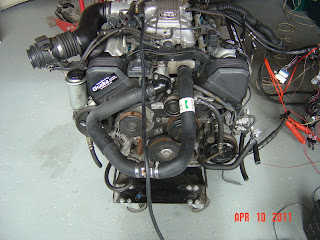It’s Alive!
Colin’s 1UZFE Lexus V8 fired into life on the floor of my garage at about 10:15 PM on Friday 8 April 2011. I have lost count of how many of these engines I have wired up now, but it must be around 35. All of them have run the factory computer, although the majority have been converted to a manual transmission.
I am a very one eyed advocate of running an engine on the factory EFI system if it is at all possible, as it is cheaper than buying, installing and tuning an aftermarket system. Many aftermarket systems are incapable of driving modern transmissions, although the emerging generation of ECUs make this less of an issue. Also a lot of people never get their aftermarket system tuned properly (often because the tuner isn’t very good) so they never have the finesse of a factory system.
That said, wiring a factory ECU up can be a bit of a challenge, unless you have access to all the information that is required. Colin’s engine is from a facelift UCF20 Celsior/LS400 sedan, which came out in 1995. This engine is an upgrade of the ‘original’ 1UZFE with key differences being:
· Sequential fuel injection (earlier engines run the injectors in pairs).
· Hot wire air flow meter (vs. optical Kaman vortex).
· Slightly different idle speed control stepper motor.
· Deletion of the cold start injector system (generally not required with sequential injection).
This results in a slight increase in power (factory quoted 208 vs. 200 kW) and economy. The 4 speed electronically controlled transmission is largely unchanged from the earlier models.
Colin’s engine has an uncut wiring loom. The engine computer (which controls the transmission as well) has four plugs, three of which attach to the uncut engine loom, with the 4th plug going to the car. The engine harness has two additional plugs that connect the engine to the rest of the car. Between them the three ‘car’ plugs have 73 terminals; my job is to determine which of these are actually needed for Colin’s car, which is a bit under half of them - even less if he was running a manual transmission.
All this results in a patch loom which in effect is the interface between the engine and the car. This contains a number of fuses and relays which not only enable the engine and trans to run just like they do in the factory car, but also enables instruments and the like to be connected (and more importantly easily disconnected if the engine ever has to be removed).
Floor running the engine once the patch loom is made up is relatively simple – all that is needed is a temporary power supply, a run and start trigger, and a fuel system. For the latter I have an outboard motor plastic fuel tank with an external fuel pump fitted, plus a return line that I splice into the on engine systems.
I also loop the cooling system and fill the block with water, to keep the water pump lubricated and let the EFI water temp sensor have something to read. Obviously you can’t run the engine for long, but to a large extent it will either start, idle and rev OK or it won’t (in which case you need to fault find) – there really isn’t an in between.
I also loop the cooling system and fill the block with water, to keep the water pump lubricated and let the EFI water temp sensor have something to read. Obviously you can’t run the engine for long, but to a large extent it will either start, idle and rev OK or it won’t (in which case you need to fault find) – there really isn’t an in between.
Noting that Colin’s engine has no exhaust system beyond the factory headers, a pair of ear protectors is wise! Interestingly enough the engine sits quite happily on its sump on the floor, even when you snap rev it and bounce it off the rev limiter.
I hard wired the fuel pump to prime the system and purge any air bubbles - ordinarily it is controlled by the engine computer so if shuts down in case of the engine stalling (like after a crash). After about 20 seconds of initial cranking the engine fired into life. It was a little rough at first and needed the throttle holding open to stabilise it, but the idle speed system quickly compensated. After that the engine started easily each time and settled into an idle with no external assistance.
The beauty of the patch loom is that once the engine is in the rolling chassis, all Colin would need is a battery and a fuel system, and he could strap himself on and drive it…
Phil Bradshaw
Thanks Phil......I also appreciate the phone call on Sunday so I could hear it for myself! Its fair to say the GAFOM hasn't been reading that high lately......click below and you'll see what I mean!
But this latest development has certainly lifted the excitement levels a bit.
.





I wouldn't know where to start on a late model engine like this because of all the wiring and sensors...wow. Things look like there coming together very nicely though so nice job guys.
ReplyDeleteCheers Kevin....it certainly starts getting exciting when milestones like that are achieved. The next big one will be getting the whole rig here at home so I can get into it.
ReplyDelete